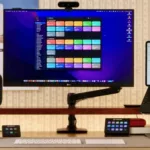Open Sound Recognition preferences
Opens the Sound Recognition section of Accessibility settings and lets you toggle the feature on or off, see how much storage is used, and choose which sounds to recognize.
Scripting Actions
Extra Details
More From This Folder
Open RTT preferences
Opens the deep link into Settings > Accessibility > RTT to let you adjust “Real-time Text,” described by Apple as “a service offering more reliability, better text support, and the ability to speak and hear during a call” with Software and Hardware options.
Open Personal Voice preferences
Opens the deep link to the Personal Voice feature available in Accessibility settings on iOS, where you can create a Personal Voice, decide whether to Share Across Devices, and Allow Apps to Request to Use.
Open Keyboard Accessibility preferences
Opens the deep link into Accessibility > Keyboards to let you toggle features like Full Keyboard Access, Key Repeat, Sticky Keys, Slow Keys, and Show Lowercase K
Open Switch Control preferences
Opens the deep link into the Accessibility settings for Switch Control, which allows you to use your iPhone by sequentially highlighting items on the screen that can be activated through an adaptive accesssory. Other options include settings for Switches, Recipe, Scanning Style, Auto Scanning Time, Pause on First Item, Loops, Move Repeat, Long Press, Tap Behavior, Focused Item After Tap, and keyboard, switch stabilization, point scanning, audio, and menu items controls.
Open Display and Text Size preferences
Opens into the Display and Text Size section of Accessibility settings and lets you customize features like Bold Text, Larger Text, Button Shapes, On or Off Labels, Reduce Transparency, Increase Contract, Differentiate Without Color, Prefer Horizontal Text, Smart Invert, Classic Invert, Color Filters, Reduce White Point, and Auto-Brightness.
Open Hearing Devices preferences
Opens the deep link into Settings > Accessibility > Hearing Devices where you can pair Made for iPhone hearing aids and sound processors, plus toggle Hearing Aid Compatibility to improve audio quality on some devi
More From The Library
Shame
Gets the base64-encoded text for the Shame sound from Game of Thrones, decodes it, and plays it twice at 75% volume with a short break in between.
Search for emails in Notion Mail
Asks you to search for emails, then opens the URL into Notion Mail with your query.
Search for a show
Asks you for a show, then passes the term into the URL scheme for TV Forecast to open into search results.
Open Apple TV Store
Opens the Srore tab of the TV app to show the top TV shows and Movies that are on sale.
Open Security and Privacy preferences
Opens the deep link into Privacy and Security settings on iOS and the Security pane on macOS. Options include controls for Location Services and Tracking, plus others like Local Network, Nearby Interactions, Microphone and Speech Recognition, and Research Sensor and Usage Data. Also includes Safety Check, Sensitive Content Warning, Analytics and Improvements, Apple Advertising, App Privacy Report, and Lockdown Mode.
Get way deeper into Shortcuts – become a member.
Browse more
Shortcuts Membership
Enhance your experience with bonus shortcuts, folder bundles, and exclusive perks.

Action Directory
Discover endless possibilities by combining the building blocks for Shortcuts.